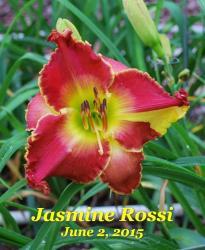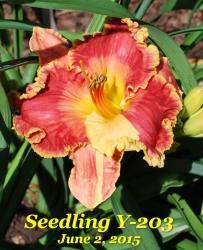Lets call the segment that is a different colour a "sector". Most sectors are probably "accidents" - something for some unknown reason went wrong while the flower was developing in the bud and that part did not develop its pigments properly. Those accidents can happen to any cultivar that produces pigments in its flowers - that is, any flower that is not pure white. The sector can be any size from extremely small (needing a microscope to see) to all the petals or sepals of the flower. Usually the ability to have those accidents is not inherited.
But sometimes sectors are caused in specific ways that can be inherited.
A daylily is made up of millions of cells. All those cells are genetically identical (more or less). Yet if we look at a daylily we see parts of the plant that do not look identical. Roots are different from stems which are different from leaves, petals, pollen, seeds, etc. How does that happen if every cell in the daylily is genetically identical to every other cell? As the plant grows and develops some of the genes in certain cells are switched on and other genes are switched off. Daylilies probably have about 25,000 different genes. For a very simplified example lets say that daylilies had only five genes - A, B, C, D and E. As a daylily grows in its seed it might turn off gene A and gene E in some cells and those would develop into roots. It might turn off gene A and genes C and D and those cells might develop into leaves and so on. With 25,000 different genes we can see that by turning on and off different genes we make a large number of different cells and tissues.
If we look at a normal red daylily flower, specifically at one of its petals we may see parts that are one colour while other parts are a different colour. In the photo of 'Prince John' above the petal edges are not red while the petal centres are red. The cells in the centre of the petal had the genes to make red pigment (anthocyanins) turned on while the cells at the edge of the petals did not have them turned on. There was an accident (a developmental accident) that caused the cells in one section of one petal to not turn on the genes to make the red pigment while the petal was developing.
There is probably a different explanation for the sector in 'Big Rose Platter'. Plant pigments, such as anthocyanin, that are found in daylily flowers are affected by sunlight. Lets say one takes a daylily bud that is about to open and places it in the dark to open. Lets say we have another bud on the same daylily on the same day that we let open in the normal sunlight of the garden. If we then compare the colours of the two flowers, and the flower colours are caused by the anthocyanin pigments they may be quite different looking. The flower that opened in the dark will have a deeper stronger colour while the one that opened in normal sunlight will have a lighter colour. The two petals with the darker sectors in the 'Big Rose Platter' flower were probably caught in the sepal on that side when the flower was opening in the morning. Because they were caught in the sepal the normal sunlight will not have reached the petal parts caught in the sepal and the sunlight will not have lightened the original petal colour. An easy test of that idea would be to remove a bud from 'Big Rose Platter' the night before it was about to open and place it in a glass with some water in a fridge or in a dark closet, or box, etc. and to compare the petal colours after the flower opened the next morning to those on a flower from the garden.


